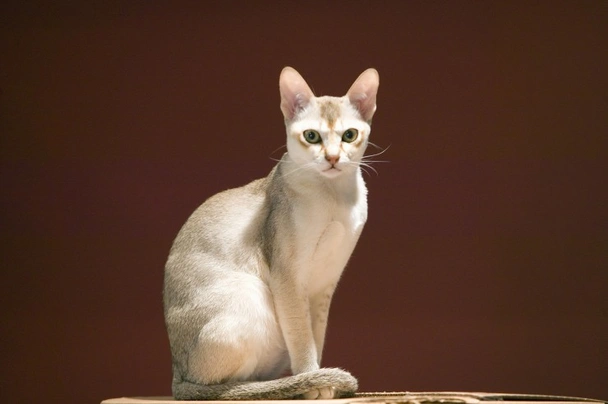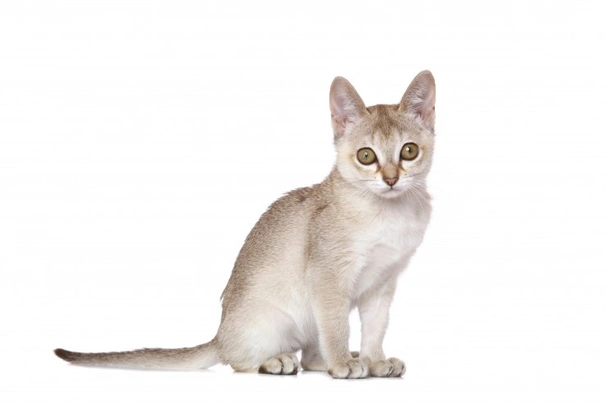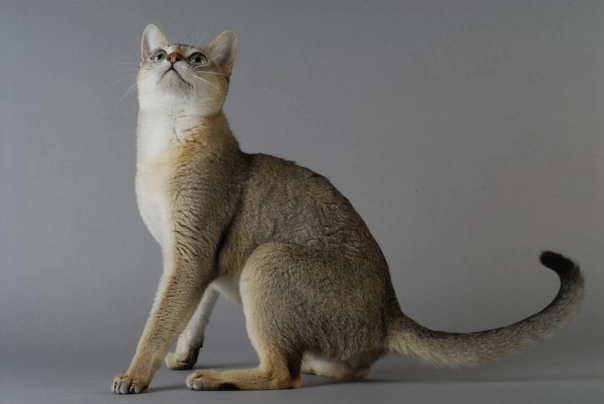Singapura
Introduction of the Singapura
The Singapura is one of the smallest breeds around and they were originally "street cats" found in Singapore. They boast having extremely large green eyes which adds to their endearing albeit mischievous appearance. They are delicate little cats that have found their way into the hearts and homes of many people not only because they are so adorable looking but also because they boast such alert active and loving natures which makes it a joy to share a home with them.
History of the Singapura
The Singapura is native to Singapore and it is thought that all the cats seen in the West today are the descendants of six cats that were found in the Loyang area of Singapore by Tommy and Hal Meadows during the 1970s. However some people believe the breed is a result of crossbreeding Abyssinians and the Burmese which then created the Singapura and they were imported to Singapore.
It was not long before people started to notice these charming little cats and interest in the breed increased throughout America during the eighties. In 1988 a British breeder by the name of Carole Thompson imported the first Singapura cat into the UK. The cat was a pregnant female named Imago's Faye Raye of Usaf. The breed was given full Championship status by the GCCF in 2005 and today these charming little cats have become popular not only in the UK but elsewhere in the world thanks to their adorable size their playful albeit mischievous natures and their loving personalities.
Appearance of the Singapura
The Singapura boasts being one of the smallest cats on the planet. They have a very foreign look about them with their large eyes big ears and warm sable nicely ticked coats. They don't fully reach their full size until they are around two years old but even then they are still extremely small cats. They have nicely rounded heads with a good width between their ears and large eyes which all adds to the breed's foreign appearance. Their muzzles are moderately short and broad with cats having a well-defined whisker break. Noses are rather blunt and when seen in profile there is a slight stop a little below their eye level. Their chins are nicely developed with cats having a straight line from the nose right to their chins.
A Singapura's ears are large being wide open at the base and deeply cupped. They have very large eyes that are set nicely apart on a cat's face and which slant when closed or partially open. Their eyes have a lovely dark outline around them and can be anything from hazel green or yellow in colour.
They boast having medium length bodies that are lithe firm and well-muscled. Their legs are muscular tapering down to a cat's small feet which are oval-shaped. Tails are slender and moderately long without being whippy and which boast having a blunt tip.
When it comes to their coat the Singapura boasts havign a short close-lying coat that's short fine and extremely silky to the touch. Their colouring is as follows:
- Body colour should be golden ivory with a warm look about it and ticked throughout with sepia brown
Each hair has at least 2 bands of ticking which is separated by lighter coloured bands. The hair is lightest closer to a cat's skin and darkest at the tip. Their muzzle stomach chest and the inside of their legs are a lighter ivory without ticking. However on the inside of their front legs and back knees cats should have some barring. The tip of the tail is dark with the colour going down towards a cat's upper side. Cats can also have a line down their spines which is acceptable under the GCCF standard of points. Their noses are nicely outlined with a darker pigment and cats have "Cheetah" lines that run from the inner corner of their eyes to a little behind their whisker pads. Singapuras have nice brown paw pads and brown spurs on the lower part of their back legs.
Temperament of the Singapura
Like a lot of other breeds the Singapura likes a routine and doesn't particularly like it when this changes for any reason. They like to be fed at the same time of the day and don't appreciate it when any furniture gets moved around the home. With this said they are known to be real extroverts that thrive on human company following their owners around the home so they can see what they are up to and which allows them to join in any activity that’s taking place.
They are quite high energy cats and being so intelligent as well as inquisitive the Singapura is also known for being a bit mischievous but this makes them all the more endearing to live with. They like to be involved in everything that goes on in their environment and not particularly fond of being left on their own for any length of time. As such they are best suited to families where at least one person stays at home when everyone else is out of the house. They are not known to be territorial by nature and enjoy the company of other cats dogs and even some small animals.
Singapuras like to be into everything and enjoy climbing up high so they can look down on the world below from a high vantage point which is something they adore doing. They like to be warm and don't tolerate cold very well which means creating lots of cosy places for them to curl up and take a nap when the mood takes them. They are quite talkative by nature and boast having soft "voices" always ready to have a conversation and let their owners know their feelings about things. They also like to make eye contact which is yet another of the breed's endearing traits.
Intelligence / Trainability of the Singapura
The Singapura is a highly intelligent small cat and one that enjoys being around people and other animals. They thrive on company and love to interact with their owners which includes paying interactive games. They adore being able to get up high so they have a bird's eye view of their surroundings and they have been known to use their vantage points to pounce on their owner's unsuspecting shoulders. Anyone sharing a home with a Singapura would need to invest in lots of good quality toys for their pet to play with. Because Singapuras are social and not territorial by nature they do well when living with other cats more especially other Singapuras.
Children and other
Singapuras with their outgoing affectionate and mischievous personalities are a great choice for families with children. They are quick on their feet and therefore know when to get out of the reach of smaller children when they get too boisterous or loud. However care has to be taken when very young children are around these small cats and any interaction should always be supervised by an adult to make sure things stay nice and calm. With this said children need to be taught how to behave around cats and when it is time to leave them alone.
They also get on well with dogs they have grown up with in a household and really do enjoy being in their company. However care has to be taken when introducing a Singapura to dogs they don't already know just in case the dog does not get on with their feline counterparts. They are incredibly social by nature and have been known to get on with pet birds and small animals. However it's always wiser to keep a close eye on any cat when they are around smaller pets particularly when they first meet just to be on the safe side.
Health of the Singapura
The average life expectancy of a Singapura is between 9 and 15 years when properly cared for and fed an appropriate good quality diet to suit their ages.
The Singapura is known to be a robust little cat. However they are known to suffer from a couple of hereditary health issues which are worth knowing about if you are planning share your home with one of these small highly intelligent cats. The conditions that seem to affect the breed the most include the following:
- Progressive retinal atrophy (PRA) - breeders should have stud cats tested
- Pyruvate kinase deficiency (PK) - breeders should have stud cats tested
- Burmese Hypokalaemia - test available
Caring for the Singapura
As with any other breed Singapuras need to be groomed on a regular basis to make sure their coats and skin are kept in top condition. On top of this cats need to be fed good quality food that meets all their nutritional needs throughout their lives which is especially true of kittens and older cats.
Grooming of the Singapura
Singapuras boast having short close lying dense extremely glossy coats and as such they are low maintenance on the grooming front. A weekly brush and wipe over with a chamois leather is all it takes to keep their coats in good condition with a nice sheen on it. Like other breeds they tend to shed the most in the Spring and then again in the Autumn when more frequent brushing is usually necessary to keep on top of things.
It's also important to check a cat's ears on a regular basis and to clean them when necessary. If too much wax is allowed to build up it can lead to a painful infection which can be hard to clear up. In short prevention is often easier than cure with ear infections. Cats often suffer from ear mites which can be a real problem which is why it's so important to check their ears on a regular basis.
Exercise of the Singapura
The Singapura is a high energy little cat and one that thrives on interacting with their owners. They love playing all sorts of games with one of their favourites being to climb up high so they can stalk their owners from a high vantage point. They are known to be quite mischievous by nature which is something that makes these little felines all the more endearing to live with. They remain playful throughout their lives bearing in mind that it takes them a couple of years to fully mature.
They are inquisitive and love to explore their environment but Singapuras should only be allowed to roam around in the great outdoors if it is safe for them to do so bearing in mind that they do feel the cold more than many other breeds. The good news is that Singapuras adapt extremely well to being kept as indoor pets providing they are given lots of things to do and places to hide when they want to bearing in mind that they love high vantage points. They also need to have lots of places they can snuggle up for a snooze when the mood takes them because if there is one thing Singapuras really enjoy it's taking a nap or two during the day.
Feeding of the Singapura
If you get a Singapura kitten from a breeder they would give you a feeding schedule and it's important to stick to the same routine feeding the same kitten food to avoid any tummy upsets. You can change a kitten's diet but this needs to be done very gradually always making sure they don't develop any digestive upsets and if they do it's best to put them back on their original diet and to discuss things with the vet before attempting to change it again.
Older cats are not known to be fussy eaters but this does not mean they can be given a lower quality diet. It's best to feed a mature cat several times a day making sure it's good quality food that meets all their nutritional requirements which is especially important as cats get older. It's also essential to keep an eye on a cat's weight because if they start to put on too much it can have a serious impact on their overall health and wellbeing. Like all other breeds Singapuras need access to fresh clean water at all times.
Singapura price
If you are looking to buy a Singapura you would need to pay upwards of £500 for a well-bred pedigree kitten and you would need to register your interest with breeders and agree to being put on a waiting list because not many well-bred kittens are registered with the GCCF every year. The cost of insuring a male 3-year-old Singapura in northern England would be £12.08 a month for basic cover but for a lifetime policy this would set you back £25.43 a month (quote as of October 2016). When insurance companies calculate a pet's premium they factor in several things which includes where you live in the UK a cat's age and whether or not they have been neutered or spayed among other things.
When it comes to food costs you need to buy the best quality food whether wet or dry making sure it suits the different stages of a cat’s life. This would set you back between £10 - £15 a month. On top of all of this you need to factor in veterinary costs if you want to share your home with a Singapura and this includes their initial vaccinations their annual boosters the cost of neutering or spaying a cat when the time is right and their yearly health checks all of which quickly adds up to over £400 a year.
As a rough guide the average cost to keep and care for a Singapura would be between £30 to £50 a month depending on the level of insurance cover you opt to buy for your cat but this does not include the initial cost of buying a well-bred kitten.




